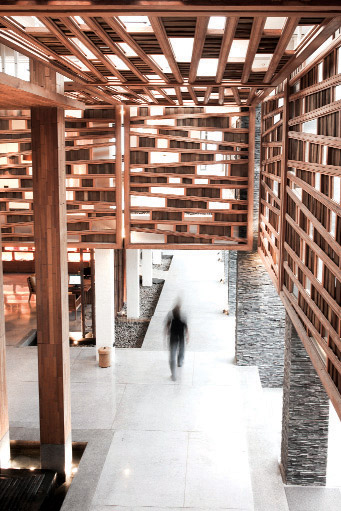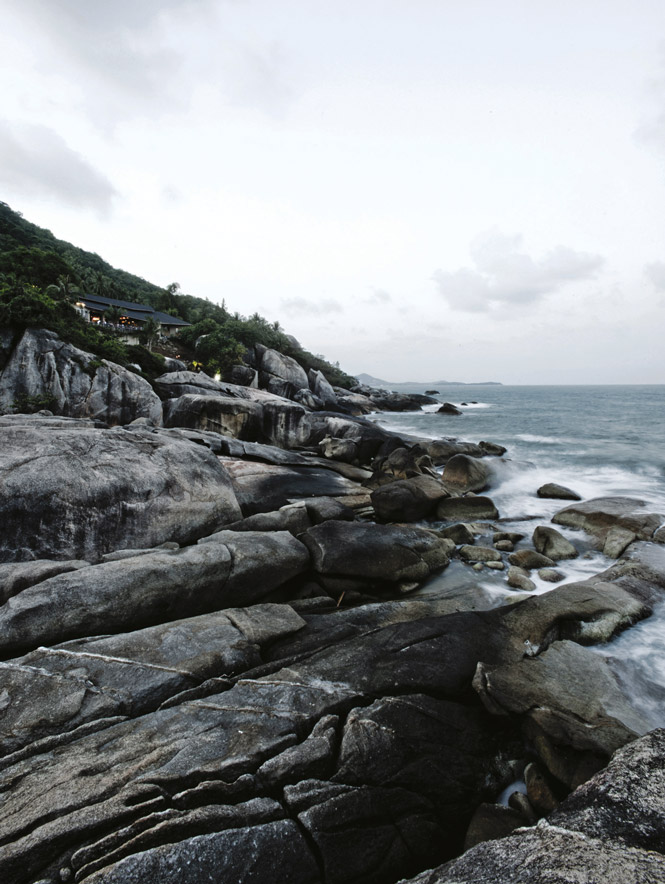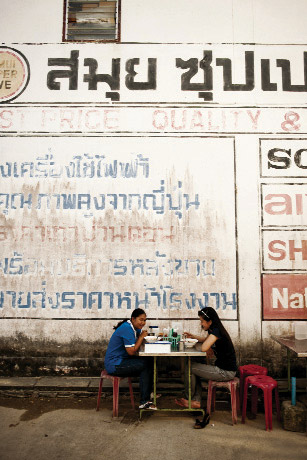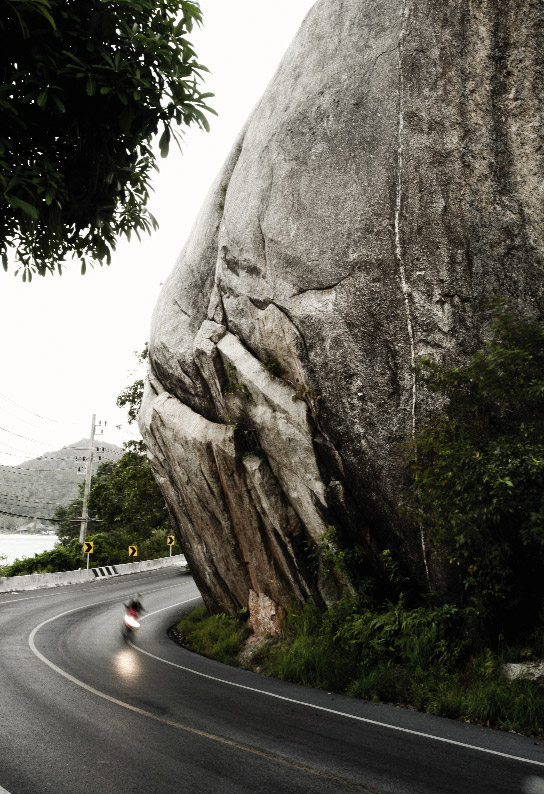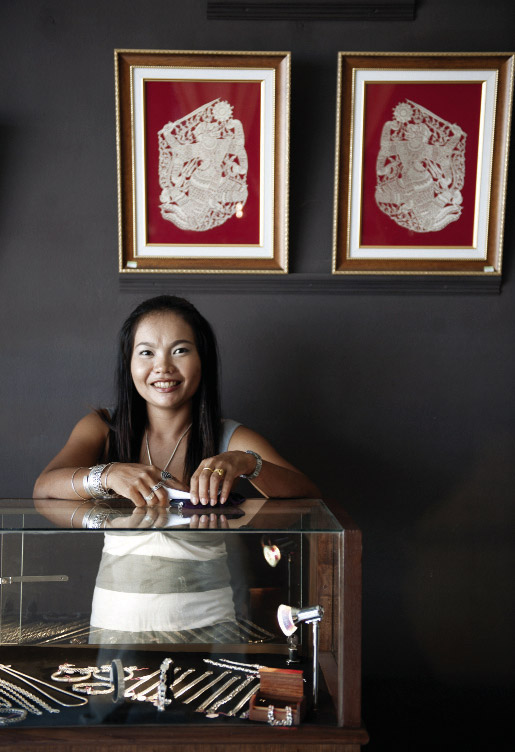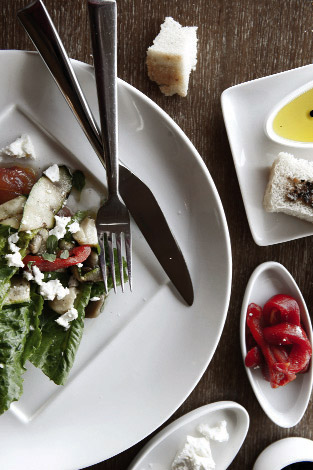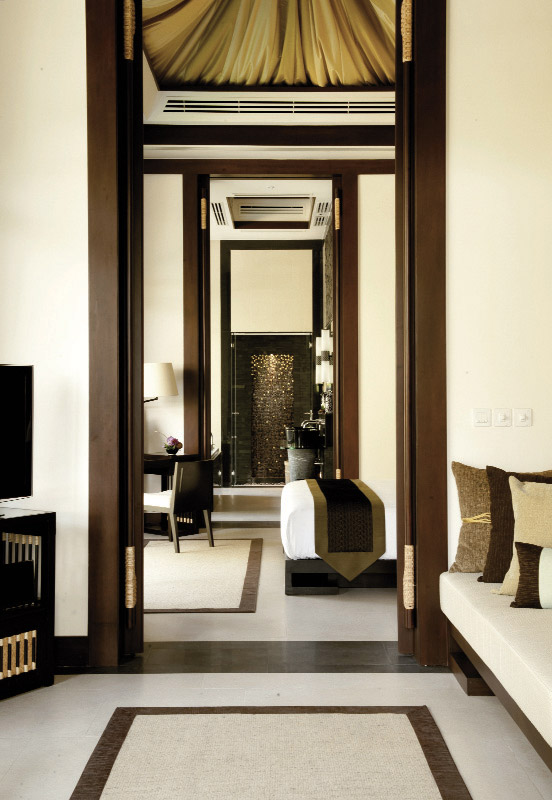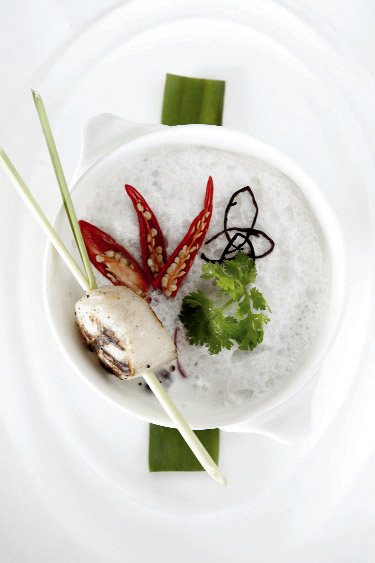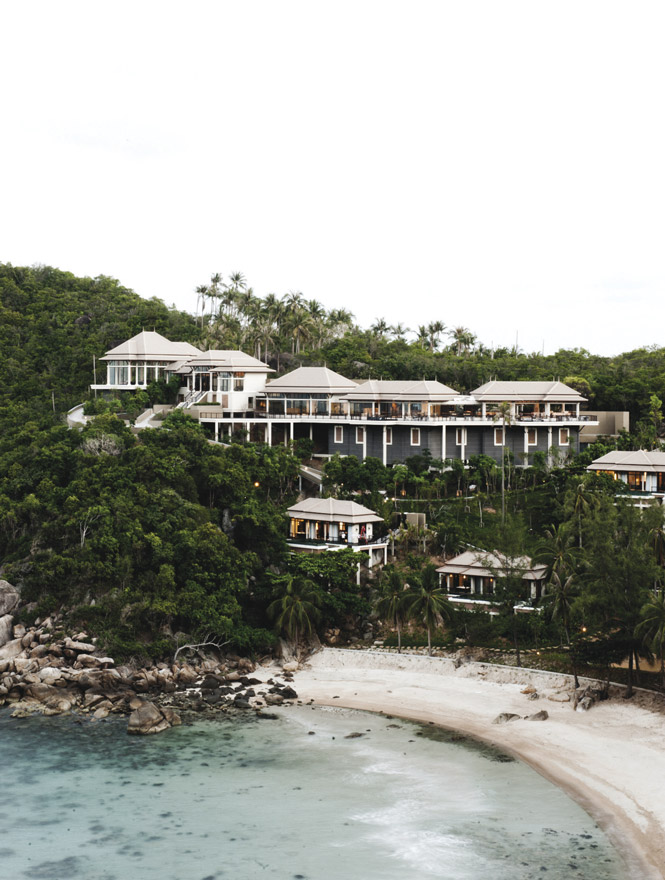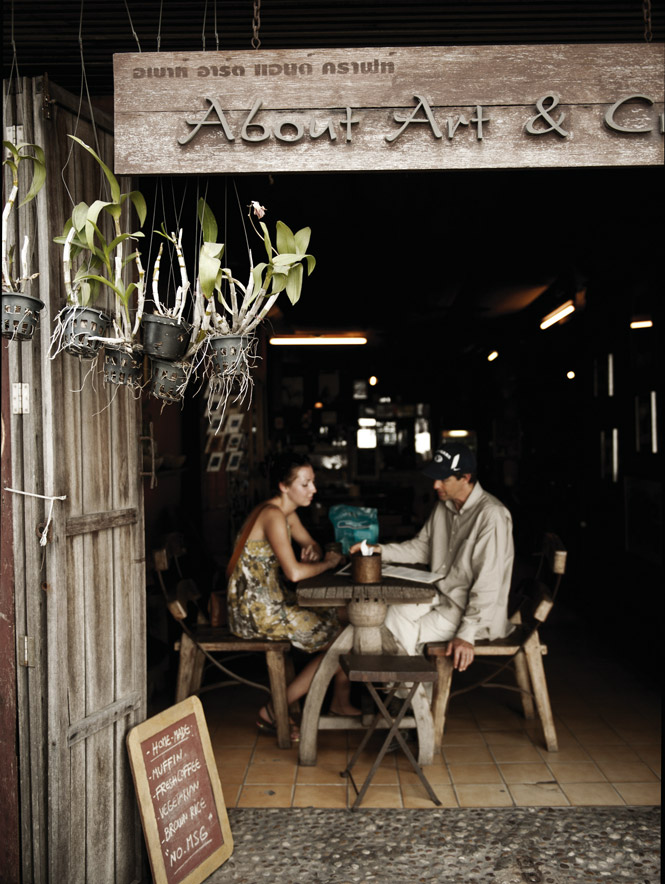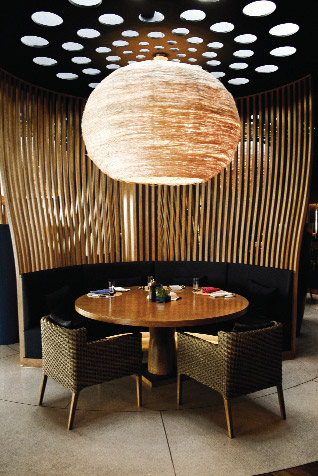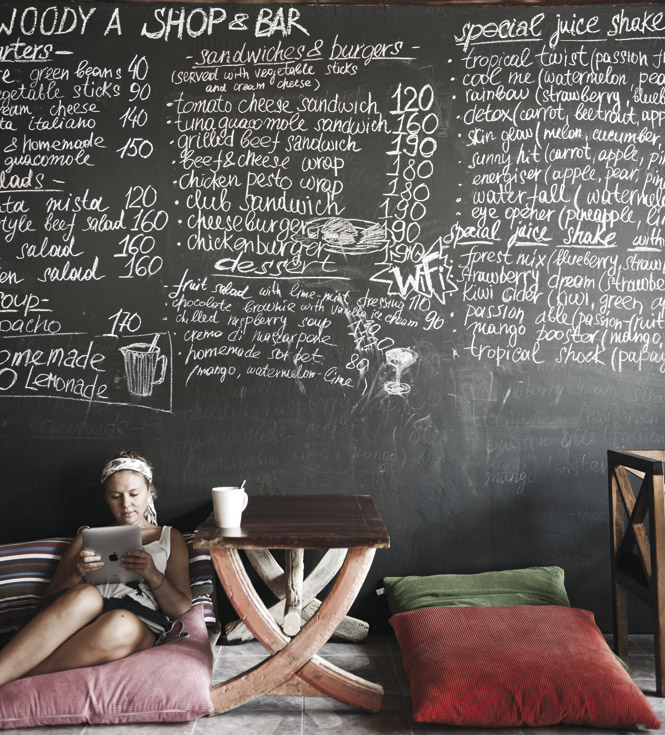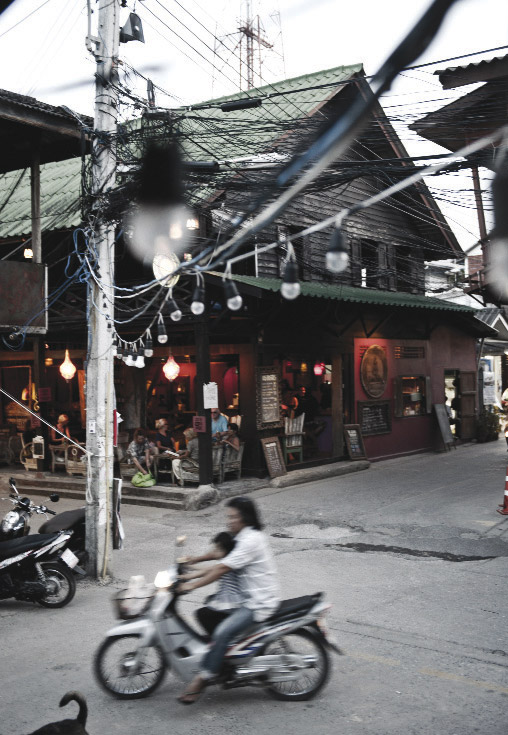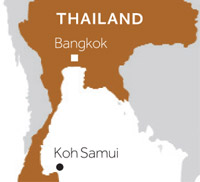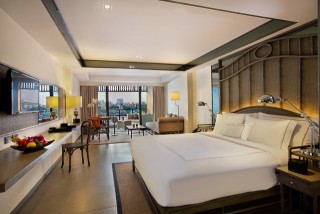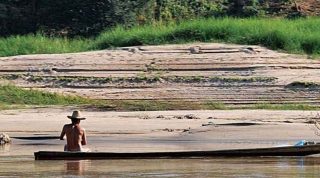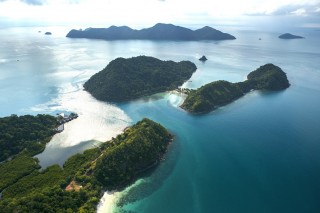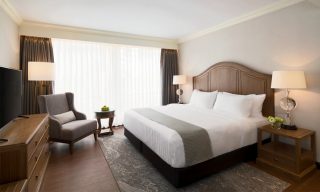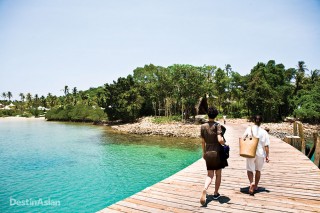Above: A lotus pond welcome area at the W.
Thailand’s most popular tourist island after Phuket, once sleepy Koh Samui is now on the map for upscale travelers, thanks to the growing number of luxury resorts and a new wave of boutiques and cafés
By Lauren Kelana
Photographs by Jason Michael Lang
On a quiet street of wooden houses in Bophut’s Fisherman’s Village, a casual shop and bar called Woody A awaits the crowds. A wardrobe full of the latest lines from local designers invites browsing, a selection of spotted ceramic teapots sits on the shelf behind the bar, a handful of tables are prettily decorated with small flower vases, and a motley variety of folding wooden chairs, bench seats, and print cushions offer a welcome respite on a hot Sunday afternoon.
Taking a seat in a folding chair on the front veranda, I get the wonderful feeling of having been welcomed into the home of a group of creative, modern bohemians. A friendly blonde waitress wanders over to take my order, but, once served, I’m left to my own devices, free to browse the shelves, try on clothes, even take a turn on the PlayStation set up alongside the bar.
Woody A is a surprise find, a café-cum-boutique that wouldn’t be out of place in one of Asia’s most stylish neighborhoods; yet here it is in Koh Samui, an island that a couple of decades ago was little more than a dot on the edge of Asia’s backpacker trail. Back then, even getting to the island, some 700 kilometers south of Bangkok, required an arduous trek. First one had to go overland to the port of Surat Thani, and then by fishing boat to Nathon, Samui’s main town. From there, adventurous travelers would be left to make their own way down the sparsely populated island’s sole dirt road in search of a secluded, pristine white-sand beach or a simple seaside bungalow to rent for the night. Later, the island became a stopping-off point on the beach-rave, full-moon-party circuit, leading to a concentration of cheap and sleazy bars and crash pads around the east-coast town of Chaweng.
Times have changed, though. The island’s powdery beaches,clear blue waters, teeming coral reefs, and dramatic rock formations couldn’t stay a secret forever. In 1989, Samui’s airport opened on the northeast part of the island. The 1990s saw an influx of tour boats, and now, with annual arrival numbers that can reach seven digits, more than 300 hotels on the island, and dozens more in the works, Samui seems firmly established as a holiday hot spot.
The transformation is so complete, in fact, that I’m greeted with a look of surprise when I ask Mikhail Romeiko-Gurko and Inna Preobrazhenskaya—the carefree young Russian couple who own Woody A—why, out of all the places in the world, they chose to open up shop in Samui. “Why not?” Mikhail responds. “It’s great here, the ultimate lifestyle for us. We came here on vacation a few times and fell in love with the relaxed attitudes and laid-back vibe of the island.” Relocating, he says, was an easy decision. “When we got back to Moscow last year we were so disillusioned that we made up our minds to move. We were totally fed up with the dreary weather and the political situation in Russia.”
Last October, the couple left Russia behind, catching a southbound plane in search of an island idyll. They rented a cheap but charming wooden shophouse and set about making a home in the upper floors and a business below, opening Woody A in December. Now, they’re urging friends from Moscow to join them. “It’s one of those places where you can dream a life, and then make it happen. Perhaps it’s something to do with Buddhism,” Mikhail muses.
Looking out at their charming street, where songbirds sing out with their parents, it’s not hard to understand why they moved. Yet however much they yearn for a simple castaway existence, they say they are just as grateful for Samui’s increasingly sophisticated breed of tourist, and the luxury hotels that provide them with clientele.
From left: Villagers digging for cockles at low tide on Choeng Mon Beach, and proudly showing off a handful of their catch; Samui’s coastal road as it winds around Elephant Rock, a granite outcrop north of Lamai; a beach bar in Bophut.
Leading the way in the latest wave of this upscale renaissance was the Four Seasons Samui, which first opened its doors in February 2007 on the island’s northwest coast. According to Rainer Stampfer, who arrived in 2006 to serve as opening manager, the island wasn’t even on the Four Seasons’ radar until a local developer approached them with a proposal. “We would have loved to be able to say that we were the ones who saw the potential in Samui, but it was a project that was brought to us,” he says. “When I arrived it still looked very much like a sleepy island. There was Chaweng on the east coast, where tourists would be found. Obviously, that’s where the island gets its backpacker image from, but there wasn’t all that much else other than that scene.” And the project site, though blessed with dramatic views and a private cove, was completely undeveloped, forcing construction workers and hotel staff to scramble up and down a dirt path. “It was just a hill with plenty of coconut palm trees—hard to imagine that it would become the resort that it is today.”
It’s clear that efforts have been made to preserve the palm groves and fruit trees that dot the grounds, but beyond that, when I arrive at the Four Seasons, I see few traces of the rugged, primitive scene Stampfer describes. Indeed, from the moment I arrive at the airport, where I find myself being rescued from a throng of sweaty tourists milling around a baggage carousel, and ushered into the cushy safety of a chauffeured Mercedes-Benz, I’m enfolded in a cocoon of luxury. The car heads north, past the quiet seaside village of Maenam, and on toward Nathon, eventually turning left, up a steep incline, into the luxury property that was once a simple palm-studded hill.
From here, the day-to-day goings-on of the island don’t seem to matter much. My mornings begin with breathtaking views across the Gulf of Thailand from La Tania, a Thai restaurant located among the treetops, and my evenings end at Pla Pla with a meal of freshly caught seafood beside the swaying palm trees of the resort’s private beach. The days pass by with kite-making and massage lessons, astrology readings, meditation, and yoga classes. The only indication that time is passing by arrives in the form of small notes from the spa placed on the bed each day, recommending signature treatments inspired by the phases of the moon.
From left : A pod chair in the lobby of the W Retreat Koh Samui;
the Africa-themed section at Namcha Tea Room.
Following in the footsteps of the Four Seasons, the Banyan Tree Samui, which opened in mid-2010 five clicks south of Chaweng in a private U-shaped cove, acts as an island within an island—complete with private villas, poolside hammocks, butler service, and an elaborate spa complex with a rain forest theme. The resort cascades down a rocky hillside toward the sea, ensuring gorgeous views from every structure. Apart from the need to scramble to avoid guests careening around in the resort’s golf buggies, life is easy, and days pass by in a haze of sunshine, good food, spa treatments, and the sound of the waves crashing against the shore. The cliff-hugging Saffron restaurant serves a pleasing selection of Thai dishes, the spa highlights local herbs and techniques, and the fitness activities include lessons in muay thai alongside more standard classes. Still, it seems at times that the closest encounters with the rest of the island, and indeed with the rest of Thailand, come in the lobby lounge, where a nautical telescope has been set up for people to watch the fishing boats floating in the distance.
That said, I am able to break away for a visit to nearby Wat Sumret, one of the oldest temples on the island. To one side of the main structure, two giant yaksa (demon) statues stand guard over the entrance to a sanctuary called the Secret Hall of Buddhas. I tiptoe past tiny ceramic vases filled with lotus buds and through the doorway into darkness, followed closely by an elderly monk. Dust and incense fill the air, and then the light comes on, flooding the hall with a golden luminescence. Along one wall of the chamber, a large reclining Buddha lies surrounded by dozens of other meditative statues, including a towering Mandalay Buddha, a rarity in southern Thailand. There isn’t a more breathtaking sight on the island.
BANYAN TREE AND THE FOUR SEASONS may keep themselves at a stately distance from the hustle and bustle of Chaweng, but they’ve undoubtedly put the island on the luxury travel map. Cementing that reputation is the latest high-profile five-star debut, the W Retreat Koh Samui, which brought its brand of party-hearty insouciance to the island’s north coast, just down the road from Bophut. Walking through reception and into the lounge, it’s plain to see that the island has moved well beyond the days when it was beloved only by scruffy,budget-minded travelers. Here, well-heeled young jet-setters are encouraged to drink, relax, and socialize to their hearts’ content, surrounded by the resort’s collection of fashion- and design-oriented coffee-table books, couches with color-coordinated sequined cushions, and bars that stay open until the wee hours.
This easygoing vibe continues beyond the welcome area; at the end of each row of beachside villas, self-service refreshment stations have been set up allowing guests the freedom to grab an ice cream or a drink en route to the beach, and the swimming pool and the well-equipped gym are open around the clock. The W’s “whatever, whenever” philosophy means that here at the resort, it’s all go, go, go—and though the rooms are spacious and comfortable, with wooden decks, giant beds, and designer furnishings, the guests that W attracts are not always the type to be happy secluding themselves within the resort’s grounds.
It’s this new breed of style-conscious young travelers, more than anyone else, that is likely to ensure the economic future of the boutiques cropping up around the island. “Our guests are constantly asking us for advice on where they can go and what they can do around the island,” explains Christian Humbert, the W Samui’s director of sales. “They don’t want to go to trashy tourist places, they want to go to stylish, interesting places that they can go home and tell their friends about. The eclectic mix of stylish boutiques and cafés in Bophut is such a welcomed introduction to the island,” he adds. “We are in the process of creating a list of recommendations and the new influx of style-conscious boutiques in Bophut are perfect.” Seeking, it seems, to appeal to precisely this demographic, Namcha, a homey teahouse in Bophut has posted a sign above its entrance, billing itself as “Where Friends Gather for Tea.” In stark contrast to the legion of bare-bones roadside cafés and restaurants built up in the area over the last decade, Namcha’s luxuriantly decorated interior is cozy, welcoming, and warm. Guests can choose from a dizzying array of teas from around the world, and consume them in Chinese, African, Japanese, or English-themed nooks. I settle on a pot of orange chai, and make my way to the African section, a semi-enclosed courtyard full of carved wooden tables and boldly patterned cushions depicting women in African attire. Before my tea has even cooled enough to drink, Michelle Ho, the shop’s straight-talking Philippine-Australian owner, stops by for a chat.
I’ve been watching her dash around the shop since I came in, struck by the air of feisty determination she projects as she directs her staff, helps her daughter with homework,and still makes time to personally greet customers. This woman is clearly serious about her business. “I’ve been coming to Samui for years,” she tells me. After bouncing back and forth between Thailand, Australia, and Singapore, trying her hand at everything from hotel management to advertising sales, she finally decided the time was right to settle on the island. “I always had Samui on my mind. This little town in particular has evolved into a sophisticated but still casual community. I’ve been passionate about tea for a long time and, with all the recent resort openings, I decided to take the opportunity to open my dream business—a place where I could run a successful business, but at the same time live a quiet life surrounded by friends and family.”
Like Inna and Mikhail from Woody A, who are calling on their Muscovite friends to join them, Michelle, too, seems determined to enlist others to join her crusade to transform Bophut into a new center for boutique, design oriented businesses. The well-spoken young waiter who serves my tea tells me he was able migrate from Manila to Samui with Michelle’s assistance, bringing his wife and daughter with him. Before I leave Namcha, Michelle even tries to convince me to stay. “Samui needs more creative young women,” she exhorts.
As I stroll down the road from the tea house, I reflect that I could find myself in worse company. Mazima, just a little way down the road, is a modern take on the street-side massage parlor, offering the same prices as their cheaper-looking counterparts, while providing a cheery, inviting environment with modern teak furniture and brightly colored walls. Next door, an eclectic clothing store called Boheme is crowded with Frenchwomen eagerly snapping up a selection of Bangkok-designed clothes. Racks of new designs are squeezed between an array of cute vintage dresses and jackets, embroidered quilts, traditional silks, and a table stacked to the roof with hats and other accessories. With its atmospheric streets and entrepreneurial spirit, the town feels full of possibility.
On the other side of the island in Taling Ngam, however, I find at least one local shop owner who seems ambivalent at best about Samui’s growing popularity. Khun Boyd, who brews a mean espresso at his beachside Organic Coffee Shop, strikes me as just the sort of businessman who will profit from an influx of high-end tourists to the island. But Boyd, who arrived here seven years ago after his native Chiang Mai had become too hectic for him, shakes his head at the thought of moving closer to Bophut, or to one of the new luxury enclaves. “Why would I do that?” he asks. “I moved here from Chiang Mai to set up a peaceful life by the sea. I came here for peace and quiet, not for money.”
Appearing equally content with one customer or with five, he says he’s not excited about the potential flood of new customers brought here by the newly opened resorts, or those who will surely visit the Conrad, the Mövenpick, and the legion of other five-star properties in the pipeline—even if they stand to benefit his bottom line. “I’m not after the crowds” he says, “I hope they don’t come. If they do, I might just have to move.”
THE DETAILS:
Koh Samui
Getting There
Bangkok Airways (bangkokair.com) has daily direct flights to Samui from Hong Kong, Bangkok, and Singapore.
When to Go
If you’re seeking blue skies and sunshine, head to Samui between December and February to make the most of southern Thailand’s dry season. From March, temperatures increase to between 28–35°C until September, when the monsoon season brings humidity and rain.
Where to Stay
** W Samui 4/1 Moo 1, Tambol Maenam; 66-77/915-999; starwoodhotels.com; villas from US$1,055.
** Banyan Tree Samui 99/9 Moo 4, Maret; 66-77/915-333; banyantree.com;villas from US$1,125, including breakfast.
** Four Seasons Samui 219 Moo 5, Angthong; 66-77/243-000; fourseasons .com; villas from US$792.
** The Library A book-oriented design hotel in Chaweng recognized for its blood-red swimming pool. 14/1 Moo 2, Chaweng Beach; 66-77/422-7678; thelibrary.co.th; studios from US$262.
** Hansar Samui This sleek new 74-room resort is located near Fisherman’s Village on Bophut Beach. 101/28 Moo 1, Bophut; 66-77/245-511; hansarsamui.com; doubles from US$182.
Places to Try
**Organic Coffee Shop A cute roadside stop on the west coast serving up the island’s best coffee. 30/5 Moo 5, Taling Ngam; 66-87/893-9669.
** Magic Alambic Rum Distillery Lessons in rum making and a taste of Thailand’s only boutique agricultural rum. 44/5 Moo 3, Taling Namuang; 66-77/419-023.
** Namcha Tea Room Thanon Bophut, Fisherman’s Village; 66-77/427-115; namchasamui.com.
** About Art & Café Nathon Beach Rd., Nathon; 66-77/236-201; juneartcafe.com
** Woody A Shop & Bar Thanon Haad, Bophut Fisherman’s Village; 66-77/8018-33759.
Originally appeared in the April/May 2011 print issue of DestinAsian magazine (“Sizing Up Samui”)
Note: Photo at top courtesy of the W Retreat, all others by Jason Michael Lang

